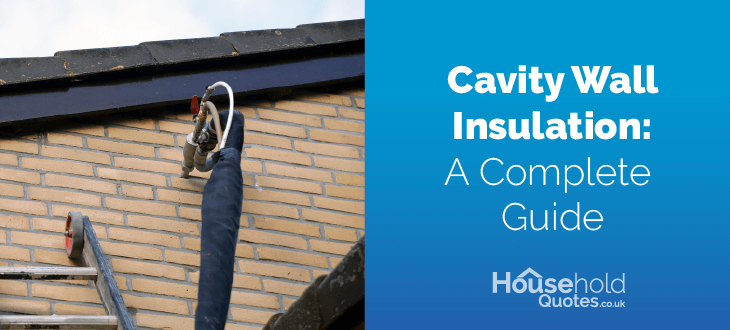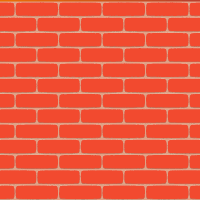
Tell us what you need to find a matching loft conversion specialist

Get free quotes from professionals near you

Compare offers and choose the one that best matches your need
- Householdquotes.co.uk
- Home Insulation
- Wall Insulation
- Cavity Wall Insulation
Cavity Wall Insulation: A Comprehensive Guide


- Cavity walls consist of an outer brick wall and an inner concrete wall with a cavity space in between.
- Cavity wall insulation can reduce up to one-third of home heat loss.
- A detached UK home with cavity wall insulation can save up to £405 in annual energy bills.
Millions of homes across the UK suffer from heat loss and high energy bills, often due to a lack of proper home insulation. Uninsulated cavity walls alone are responsible for up to 33% of domestic heat loss, making it harder and more expensive to maintain comfortable indoor temperatures.
The good news: cavity wall insulation offers a powerful solution that boosts your home's energy efficiency, slashes your energy bills, and contributes to a greener future all with one cost-effective home upgrade. Better yet, the process is mess-free, non-invasive, and takes only a couple of hours to complete.
If you’re curious as to what cavity wall insulation is, this guide by Household Quotes UK will give you everything you need to know. Read on to learn about the benefits and processes, the best materials, costs, and available grants, ensuring you make the best decision for your home.
Ready to enjoy sky-high savings? Look no further than Household Quotes UK to land the best bargains on cavity wall insulation. Instead of spending countless hours surfing the internet and scheduling phone calls for the right installer, spend just 30 seconds filling out our online form, and we’ll deliver up to 3 free home-tailored quotes from trusted local installers right to you. Click below to begin!
- Describe your needs
- Get free quotes
- Choose the best offer
It only takes 30 seconds



What is cavity wall insulation?
Unlike solid walls made from a single layer of brick or concrete, cavity walls feature a separate outer and inner wall with an air gap in between. This space hidden in between the two walls is called the cavity, and it plays a crucial role in keeping your home warm.
Commonly, the cavity space needs to be at least 50mm to be able to install insulation. Some older cavity wall properties may have up to 100mm cavity wall insulation in place, with rare occurrences of homes with up to 150mm cavity wall insulation in some older homes.

If you're unsure if your home has cavity walls, take a look at the brickwork pattern. Cavity walls typically showcase a symmetrical and even arrangement of bricks, laid lengthways.
While the main purpose of a wall cavity is to prevent moisture that the outer wall is in contact with from reaching the inner wall, the cavity space can also accommodate insulation material, which is injected with specialist equipment through a series of access holes drilled from the outer wall.
This relatively quick, cost-effective insulation process leaves no visible changes to your home's outer appearance, making it one of the easiest home upgrades to implement.
How do you insulate a cavity wall?
Insulating a cavity wall requires a professional accredited installer, it cannot be handled DIY. Thankfully though, it is a really quick process that produces minimal disruption and mess, only taking a few hours at most. Here’s a breakdown of the full process:
- Pre-installation inspection: A qualified installer first thoroughly assesses your walls to ensure they meet the necessary conditions for insulation. They check for outstanding issues, including moisture buildup, outdated insulation, and wall damage to ensure these are solved before proceeding. Any existing electrical wiring within the cavity must also be relocated to prevent fire hazards.
- Accessing the cavity: Once the inspection is complete, the installer drills small holes around 25mm at spaced intervals in the outer brickwork. This minimally invasive approach allows access to the cavity from the outside without having to disrupt your home appearance or inner environment.
- Insulation injection: A specialised applicator hose is used to inject insulation material into the cavity. Common materials include mineral wool, polystyrene beads, or expanding spray foam.
- Sealing the holes: After the insulation material is filled into the cavity, the installer seals the drilled holes with a cement mix, ensuring your home's exterior remains intact and visibly unscathed.
To make the best choice for your home, it’s recommended to conduct a home assessment before undergoing cavity wall insulation. Most professional installers even offer inspections for free or at minimal costs.
Common cavity wall insulation problems
The most common cavity wall insulation problems generally stem from improper installation and poor workmanship. A faulty job can lead to huge repair costs that exceed your initial installation, becoming a financial burden for you down the line.
This is why it’s extremely important to work with a professional accredited installer who knows what they are doing. The main seal of professionalism for cavity wall insulation in the UK is provided by the Cavity Insulation Guarantee Agency (CIGA). Jobs carried out by CIGA-approved installers even have a 25-year guarantee on cavity wall insulation.
In any case, it’s good to know what poor cavity wall installation could lead to. Here are some of the most common cavity wall insulation problems:
- Poor sealing: Gaps around the drilled access points can allow moisture ingress, leading to the development of mould. This in turn will damage your insulation, reducing its effectiveness.
- Insufficient insulation: Inadequate insulation filling leaves voids that compromise the performance of your insulation material. These voids can also build up moisture.
- Damaged brickwork: Drilling into weakened brickwork can cause further damage to your property's facade. It can also make it very difficult to keep the cavity space away from weather conditions, leading to moisture buildup.
- Ventilation issues: Cavity walls require proper airflow to prevent moisture build-up and insulation deterioration. Overfilling the cavity can restrict this ventilation, leading to moisture in your insulation and inner home walls.
- Outdated insulation materials: Older materials like formaldehyde foam or EPS beads may be present in some cavity walls that were previously insulated. These offer lower insulation value compared to modern alternatives like mineral wool, polystyrene beads, or spray foam, and may need removing before re-insulating.
- Unsuitable walls: Walls with existing dampness, cracks, mould growth, or poorly removed old insulation require these issues to be addressed before installing new insulation.
By understanding these potential issues and taking necessary precautions beforehand, you can maximise the benefits of cavity wall insulation and create a more energy-efficient, comfortable living environment for decades to come.
What materials are best for cavity wall insulation?
The best cavity wall insulation will depend on several factors, including your budget, the type of home you have, and sustainability concerns. Generally speaking, there are three main cavity wall insulation types; mineral fibre, polystyrene beads (EPS), and spray foam insulation.
Here's a breakdown of the three most common cavity wall insulation options:

Mineral fibre is an affordable, popular and easy-to-obtain insulation material that has been a popular budget-friendly choice for many UK homeowners. Typically, mineral fibres cost around £14 to £20 per square metre.
Made from glass or rock, these mineral wool fibres are injected into the cavity space with specialist equipment, just like blown insulation. With a proper installation and healthy ventilation space, mineral fibre provides an effective choice for cavity walls.
- Cost-effective: Mineral wool is one of the most affordable options on the market.
- Eco-friendly: Made from recycled materials like rock and glass, mineral wool is a sustainable choice.
- Moisture damage: Susceptible to moisture buildup that reduces insulation effectiveness and encourages mould growth. Careful installation is required to prevent air leaks.
- Expensive removal: Cavity wall insulation removal can be costly. Mineral fibre that is damaged can be very expensive and time-consuming to remove from the cavity space.

Polystyrene beads (EPS) are an innovative insulation material that has an outstanding thermal performance, is budget-friendly, and even water-resistant, helping keep your insulation effective for much longer. Typically, EPS polystyrene beads cost around £18 to £22 per square metre.
Better yet, polystyrene beads can be sustainably used even if they aren’t a natural product. This is because it’s possible to recycle them by breaking them down to their original components to be made into new polymer-based products.
- Moisture resistant: EPS beads boast excellent water resistance, allowing them to dry out even when exposed to damp conditions.
- High performance: Polystyrene beads offer an impressive insulation value, similar to rigid insulation boards.
- Recyclable: EPS beads can be recycled after removal. This is done by breaking down the beads into their original components to be made into new products.
- Price: More expensive than mineral wool insulation.
- Voids: When polystyrene beads come loose from the bonding agent over time, this can create voids where moisture buildup can occur.

Spray foam insulation is a top performer in terms of heat retention capabilities, but has a hefty price tag to go along with it, typically costing around £22 to £26 per square metre.
Spray foam is normally made from polyurethane (PUR) or polyisocyanurate, both of which expand to fill in the cavity space when injected with specialist equipment.
- Top performer: Spray foam boasts the highest heat retention rate of the three options, significantly reducing heat loss in your home.
- Mould-resistant: Spray foam insulation is highly resistant to mould growth.
- Price: Spray foam is one of the most expensive insulation materials on the market.
- Unsustainable: Spray foam is the least eco-friendly option, is not recyclable, and can release harmful VOCs and gases.
- Shrinking: Spray foam can shrink over time, reducing its effectiveness and potentially causing water damage.
For budget-conscious homeowners, mineral wool offers a cost-effective solution, but be aware of moisture risks. For those prioritising sustainability mineral wool or EPS beads are both good eco-friendly choices. For the best insulation performance, spray foam offers the best heat retention, but do consider the environmental impact and potential ventilation issues.
How much does it cost to insulate a cavity wall?
Wondering how much is cavity wall insulation? A cavity wall insulation cost generally depends on your type of home, as well as some other factors and preferences. For a standard semi-detached UK home, the cost sits at around £2700.
Despite what may seem a hefty upfront cost, proper cavity wall insulation can bring a semi-detached home up to £235 in annual savings, allowing you to pay off your investment in just over a decade.
For a full understanding, here’s a summary of the cavity wall insulation cost per type of home, and expected annual energy bill savings:
| Type of home | Average price (£) | Annual savings (£) |
|---|---|---|
| Flat | £1000 | £110 |
| Mid terrace house | £1500 | £140 |
| Semi-detached house | £2700 | £235 |
| Detached bungalow | £2100 | £175 |
| Detached house | £4600 | £405 |
For the best picture of your costs and savings, it’s recommended to consult with a professional installer for a housing assessment before a cavity wall insulation job. In most cases, professional installers provide assessments for free or reduced costs.
Grants to insulate your cavity walls for less or for free
The UK government is committed to making the domestic housing stock more energy-efficient by 2050. This not only helps the environment but also saves big money on heating bills for UK homeowners.
In a bid to speed up the process, there are cavity wall insulation grants available to assist qualifying households in energy efficiency upgrades. Two main schemes that offer free or reduced-cost cavity wall insulation are:
- The Great British Insulation Scheme (GBIS): This government-run scheme provides free insulation (including cavity walls) to qualifying households. To apply, visit the UK government website and complete a short application. A home inspection will then be conducted to determine the most suitable upgrade for your property.
- The Energy Company Obligation (ECO4) Scheme: This scheme places the responsibility on energy providers to offer energy efficiency measures like cavity wall insulation to eligible customers. The specific measures may vary between providers. Contact your energy supplier to see if you qualify and how to apply.
Both schemes are active until March 2026, giving you a timely opportunity to explore cavity wall insulation grants to improve your home's energy efficiency.
Taking advantage of these schemes is a great way to make your home more energy-efficient whilst saving money on installation costs, all while doing your part for the environment.
Who is eligible for a cavity wall insulation grant?
For both UK government-backed schemes, households eligible for cavity wall insulation grants must meet a series of criteria and requirements. Here are the main criteria to look out for:
- Low-income households: Both grant schemes prioritise homes experiencing fuel poverty and financial difficulties as primary candidates.
- Energy Performance Certificate (EPC) ratings: Homes with an EPC rating of D, E, F, or G are prime candidates, as these ratings indicate homes that fall drastically short of the UK's energy efficiency targets.
- Council tax bands (England only): Homes in council tax bands A to D are highly likely to qualify for free cavity wall insulation under the main grant schemes.
- Benefits recipients: If someone in your household receives certain government benefits or allowances, you might be eligible for insulation assistance.
For a full understanding, you can find more details about the Great British Insulation Scheme on the UK government website. For the ECO4 scheme, you should contact your energy supplier directly to learn more about the application process and requirements.
Is cavity wall insulation worth it?

Cavity wall insulation is one of the most cost-effective investments for your home's energy efficiency, making it worth the investment. It delivers a wealth of benefits for your home, your wallet, and the environment. Here are just some of the advantages:
- Slash your energy bills: Uninsulated walls force your heating system to work harder to maintain warmth. Cavity wall insulation acts as a thermal barrier, significantly reducing heat loss and lowering your energy bills. Detached UK homes can see savings of up to £405 annually!
- Reduce your carbon footprint: The UK has a reputation for energy-inefficient housing. Cavity wall insulation tackles this issue head-on by minimising heat loss and reducing your reliance on heating. This translates to a significant environmental impact, with detached homes achieving a potential CO2 reduction of 1.1 tonnes per year!
- Create a healthier home: Damp and drafty spaces are breeding grounds for mould and rot, posing a threat to your property and your health. Mould exposure can exacerbate respiratory problems and asthma. Cavity wall insulation helps maintain a consistent temperature, preventing dampness and creating a healthier living environment.
- Boost your property value: Installing cavity wall insulation improves your home's Energy Performance Certificate (EPC) rating, a key indicator of energy efficiency. A higher EPC rating translates to a more valuable property, giving you an edge in the rental or resale market.
By investing in cavity wall insulation, you're making a smart choice for comfort, cost savings, and environmental responsibility. It's a win-win for you and your home. However, finding the right professional installer can be a difficult task. The process of researching and vetting alone can see you spend countless hours on the web. That’s where Household Quotes UK comes in.
With our services, you can gain access to our pre-vetted network of professional UK installers. Simply fill in our quick 30-second form and receive up to 3 free home-tailored quotes from installers right in your area. Click below to begin!
- Describe your needs
- Get free quotes
- Choose the best offer
It only takes 30 seconds



FAQ
The greatest disadvantage of cavity wall insulation is that any insulation material injected into the cavity space will inevitably reduce the space for healthy air ventilation. That’s why it’s very important to work with a professional installer and use high-quality materials so that you can avoid moisture buildup, mildew, and mould growth in your cavity space.
There are available grants for free and reduced-cost cavity wall insulation through two key schemes in the UK; the Great British Insulation Scheme (GBIS) and the Energy Company Obligation (ECO4) Scheme. Both are active until March 2026 and also provide a range of other home energy efficiency upgrades.
If poorly installed or sealed, cavity wall insulation can lose its effectiveness quite quickly if exposed to moisture. This dampness can leech onto insulation material and soak into your inner wall, also resulting in mould growth and insulation damage. Working with a CIGA-accredited installer can ensure you avoid such issues.
The best insulation for cavity walls is likely EPS polystyrene beads due to their good balance between budget-friendliness, durability, and sustainability. Polystyrene beads are also waterproof, thus further reducing the risk of inner cavity moisture buildup.

Akif has a keen interest in green home improvement solutions and the role of digital media in identifying climate trends. He aims to provide a multidisciplinary approach to content rooted in credible research and accuracy.
